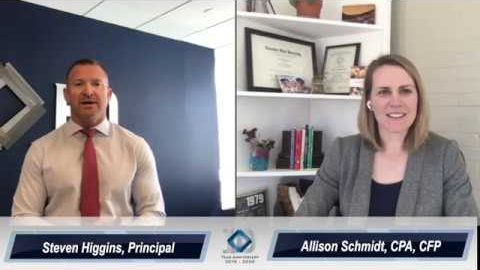Three Tips to Start 2018 Off Right
By Allison Schmidt, Financial Advisor, CFP®, CPA
Happy New Year! 2018 is upon us. Many people use this time of year to craft their latest New Year’s resolution.
Here are a couple tips to start this new year off on the right foot:
- Take an inventory of your workplace benefits: There are a number of benefits offered through employers that go un-utilized every single year because employees are just not paying attention. These benefits range from health insurance and retirement plans to discounts around town. If you work for a large employer, you may actually be able to get discounts just for being an employee (RTD passes, airport parking etc.). For your retirement plan (if your employer matches), remember the only way you receive a “match” is if you contribute. Folks, it’s free money available to you, don’t leave it on the table! For example, if your employer will match 50% up to 6% of your salary, a.k.a. 3%, be sure you’re contributing at least 6% to get that full 3% match. A report released in May of 2015 by the independent investment advisory firm Financial Engines found that 1 in 4 employees is missing out on receiving the full company match by not saving enough—leaving an average of $1,336 on the table each year, an estimated $24 billion altogether. This is in addition to employees not taking advantage of wellness programs, personal development programs, vendor discounts, and potentially various other perks for being a part of the corporate team. Don’t let that be you. In the next week, grab a glass of wine and park it on the couch to peruse through all of your offered benefits to explore what’s available to you.
- Create a budget that actually works: I can hear the groans already, but just hear me out. Different types of budgets work for different people. There are few people who enjoy sitting down with a spreadsheet and tracking through all of life’s expenses. For many it’s too time consuming and feels restrictive. So if you fall into that category of spreadsheet haters, try simplifying. First, take at least 20% of your after-tax income and save it. Next, look at your spending as 2 different categories: wants vs needs. Try to keep your needs to 50% or less of your income after taxes and the remaining 30% should be allocated to wants. Certainly not everyone will fall into those nice clean categories right off the bat, so the percentages may take a little adjusting at first. For example, if you’re focusing on paying down debt, your savings may fall below that 20% mark. But, once you fine-tune the percentages that work for you and family, the most important step is to automate. Automate everything so that you don’t have to make the decision every single month. When you get paid, the next day have the cash automatically go to each respective category/account to be available when the need or want arises.
- Look at your insurance plans: Once these plans are in place: life insurance, car insurance, home insurance, health insurance, etc. most people don’t reassess. However, our needs are always changing, so it’s important to reassess your insurance plans once a year and make sure you’re not under-insured but also that you’re not over-insured so that each of these plans protects you and your family appropriately. Perhaps, you initially set up your car and home insurance with a minimal deductible because you had less cash flow than you do now. If you are making more and can afford a higher deductible, consider increasing that deductible to save on monthly or annual insurance costs. For each insurance plan, ask yourself why you got the coverage in the first place. It was likely to protect yourself from something happening. Do you still have that risk? Is your coverage adequate to cover the risk? For example, if you purchased life insurance when you had your first child, but now you have 3 children, does that first policy still provide enough coverage for your family if something were to happen to you. There are all sorts of good reasons to purchase insurance, just be sure that your current policy still matches your current situation.
New Year’s Resolutions are notoriously difficult to keep! But making a concerted effort to dial in some aspects of your overall financial life will certainly start 2018 off on the right foot and likely pay off in the long-run, even if you only do periodic check-ins. Here’s to a a prosperous, healthy, and fun filled 2018! For more articles by Allie Schmidt and her team at HD Wealth Strategies, check out our blog at www.hdwscolorado.com/blog.
Securities offered through LPL Financial, Member FINRA/SIPC. Investment Advice offered through HD Wealth Strategies, a registered investment advisor and separate entity from LPL Financial. The opinions voiced in this material are for general information only and are not intended to provide specific advice or recommendations for any individual. All performance referenced is historical and is no guarantee of future results. All investing involves risk including loss of principal. No strategy assures success or protects against loss. This is a hypothetical example and is not representative of any specific situation. Your results will vary. The hypothetical rates of return used do not reflect the deduction of fees and charges inherent to investing. This material contains only general descriptions and is not a solicitation to sell any insurance product or security, nor is it intended as any financial or tax advice.










